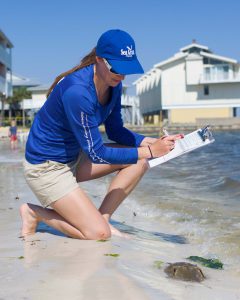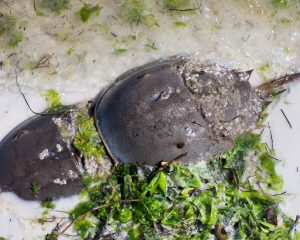- Horseshoe crabs are a vital part of Florida’s coastal ecology.
- Their eggs are a major food source for shorebirds migrating north as well as many fish species.
- A statewide Horseshoe Crab Watch is expanding into Miami-Dade County and volunteers are needed to help determine the status of their population in South Florida and increase knowledge.
MIAMI, Fla – Miami-Dade County has joined the statewide Florida Horseshoe Crab Watch, and volunteers are needed on Saturday, Feb. 12 to get a citizen science project rolling.

If walking on the beach is something you enjoy, then mark your calendars, register and head for Crandon Park North Beach, located at 6767 Crandon Boulevard in Key Biscayne. The first hands-on training for volunteers will take place from 9 a.m. to noon, when participants will learn techniques in horseshoe crab identification, biology, surveying and tagging. Volunteers must be age 16 and older to participate in the program.
Registration is required for the training and is available from this link https://bit.ly/3rJrHQv
Launched in 2015, the Florida Horseshoe Crab Watch is a volunteer-based, citizen science program founded as a partnership by University of Florida Institute of Food and Agricultural Sciences (UF/IFAS) Extension, Florida Sea Grant, and the Florida Fish and Wildlife Conservation Commission. It was created to increase knowledge about the horseshoe crab population in Florida.
The program started in Cedar Key at the UF/IFAS Nature Coast Biological Station and has grown into a statewide initiative.
“We are very excited to expand this program into Miami-Dade County,” said Ana Zangroniz, Florida Sea Grant agent for UF/IFAS Extension Miami-Dade County. “Aside from a handful of citizen observer reports, we lack data and monitoring for horseshoe crabs in the county. Establishing the watch program here will give us the opportunity to begin building that dataset.”
The program takes advantage of the fact that horseshoe crabs come ashore this time of year to nest on beaches. Volunteers walk a known section of beach at predetermined times and count the number of horseshoe crab mating groups observed. Surveys will take place during the daytime peak high tides during the months of February, March and April.

Small subsets of crabs are collected, measured, tagged with a small, numbered disc, and released back into the wild. Reports of tagged horseshoe crabs help track crab movements and reappearances on beaches.
“We need to build sufficient volunteers to survey at Crandon Park, Crandon Marina, Virginia Key North Point, and potentially Matheson Hammock Park and are asking for help from anyone to help,” said Zangroniz.
The purpose of the program is to assist biologists in surveying, tagging and re-sighting Florida’s nesting horseshoe crab populations using a standardized scientific protocol. These data help round out knowledge about this unique marine animal in Florida. The efforts also allow researchers to track movement of horseshoe crabs and note population trends. In turn, that helps FWC leaders develop improved management strategies to protect horseshoe populations.
For more information, contact Zangroniz at azangroniz@ufl.edu, or 305-421-4017.
-30-
by Lourdes Mederos
The mission of the University of Florida Institute of Food and Agricultural Sciences (UF/IFAS) is to develop knowledge relevant to agricultural, human and natural resources and to make that knowledge available to sustain and enhance the quality of human life. With more than a dozen research facilities, 67 county Extension offices, and award-winning students and faculty in the UF College of Agricultural and Life Sciences, UF/IFAS brings science-based solutions to the state’s agricultural and natural resources industries, and all Florida residents.
ifas.ufl.edu | @UF_IFAS
 0
0
